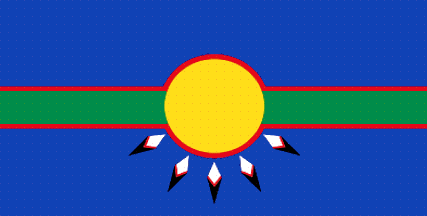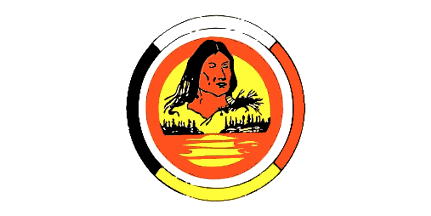Treaty One
Treaty One Flag
The Treaty 1 flag is a powerful symbol representing the historical agreement between the Crown and the seven First Nations that signed Treaty 1 in 1871. This treaty marked the first of the numbered treaties in Canada, setting a precedent for negotiations and agreements between Indigenous peoples and the Canadian government. The flag encapsulates the enduring spirit, resilience, and sovereignty of the Treaty 1 Nations while serving as a reminder of the commitments made by both parties in the original treaty.
The Treaty 1 flag is a 1:2 rectangular horizontally bicolour design that incorporates several meaningful elements. The upper green half epresents the land, emphasizing the deep connection between the Treaty 1 Nations and the Earth. The bottom blue half epresents the water, acknowledging the importance of rivers and lakes to the livelihood and spirituality of the people. The Red Stripe through the centre symbolizes unity and the bloodline that connects all the nations. The yellow circle is a stylized sun symbolizes life, hope, and renewal with the rays extending outward represent the strength, resilience, and unity of the Treaty 1 First Nations. While the design may vary slightly among communities, the flag’s core elements emphasize a connection to the land, water, and the spiritual beliefs held by the seven signatory First Nations: the Anishinaabe (Ojibwe) and Swampy Cree peoples of the Brokenhead Ojibway Nation, Peguis First Nation, Sagkeeng First Nation, Long Plain First Nation, Roseau River Anishinaabe First Nation, Sandy Bay Ojibway First Nation, and Swan Lake First Nation.
Map of the Numbered Treaties
The Treaty 1 agreement was signed on August 3, 1871, at Lower Fort Garry, Manitoba. The treaty established a formal relationship between the Crown and the First Nations, defining land-sharing agreements and promises for education, healthcare, and annuities. For Indigenous peoples, Treaty 1 was a sacred agreement meant to ensure mutual respect and coexistence. However, the subsequent implementation often fell short of its intended spirit, leading to disputes and the erosion of Indigenous rights and lands. The Treaty 1 flag emerged as a visual affirmation of these historical promises and the enduring presence of Indigenous sovereignty. It is often raised during significant events, such as anniversaries, ceremonies, and community gatherings, to acknowledge and honor the treaty’s legacy.
Today, the Treaty 1 flag stands as a symbol of reclamation, resilience, and reconciliation. Its presence in public spaces, governmental events, and educational institutions signifies a commitment to acknowledging the treaty’s importance and the rightful place of Indigenous peoples in Canada’s history and future. For many, the flag is not just a reminder of the past but also a call to action for fulfilling treaty obligations and fostering understanding between Indigenous and non-Indigenous peoples.
Treaty One Communities
Recently Posted
Categories
- Alberta 1
- Armed Forces 1
- British Columbia 1
- Canada 31
- Cities 6
- Government 3
- Indigenous 2
- International Flags 2
- International Organizations 2
- Manitoba 1
- New Brunswick 2
- Newfoundland 1
- Northwest Territories 1
- Nova Scotia 2
- Nunavut 2
- Ontario 2
- Police 1
- Prince Edward Island 2
- Quebec 1
- Royalty 3
- Saskatchewan 2
- Sports 1
- Yukon 1











